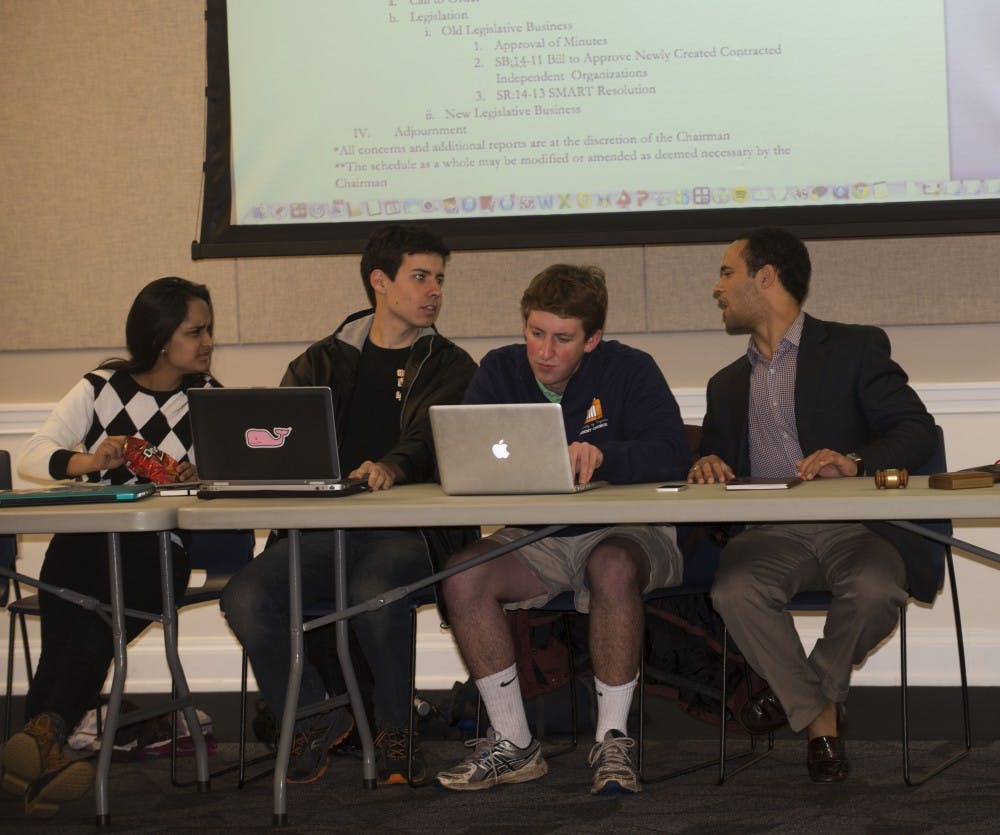At its Tuesday night meeting, just weeks after the newest executive committee was sworn in, Student Council passed a landmark resolution in regards to sexual misconduct at the University. The Sexual Misconduct Awareness, Recovery, and Tangible resolution, or SMART, offers proposals to raise awareness and offer resources to survivors by working with both student groups and University administrators. Seven clauses outline changes to student education, involvement and administrative action.
“The ultimate goal here is to put sexual assault on the map,” said Council President Jalen Ross, a third-year Engineering student. “The perfect world is one in which we don’t have to have a special sexual misconduct policy on Grounds. That is the only way to continue with the community of trust, and that is the ultimate goal. So we need to figure out what tangible steps we can take right now to get closer to that.”
A SpeakUpUVa petition posted in late January of this semester by third-year College student Amy Miller prompted the drafting of the resolution. Miller’s petition called for sexual misconduct to be considered an honor code offense. According Ross, this is not the first time the University has seen this suggestion.
“We talked to the administrators who have been around here long enough to realize that essentially every six months, making sexual assault an honor offense comes up again,” Ross said.
These requests are typically met with some level of dismissal, as the Honor committee requires a higher standard of proof than the law allows in cases of sexual misconduct.
“What was frustrating to me and the Council is that the conversation always ended there,” Ross said. “As Student Council, it’s our duty to give a voice to concerns that we’ve heard from a lot of people about sexual assault policy.”
Members of the Student Council drafted the SMART resolution through consultation with groups involved in sexual violence awareness, including One Less, Take Back the Night and the Sexual Misconduct Board.
“It’s been an effort of everyone on Council,” Ross said. “A lot of us have worked really hard crafting the language after discussing ideas and getting representatives from every sort of sexual assault group at the University, so it’s really been sort of a group effort.”
The first two clauses of the resolution call for student and University employee training in bystander intervention and victim counseling. Student organizations such as One Less and One in Four currently offer bystander intervention education programs, and Council plans to work with them to create a more central and organized solution.
“Last fall [the Class of 2017] went to [John Paul Jones Arena] and listened to a speaker talk about this, and it wasn’t as effective,” said Council representative Catalina Pinto, a first-year College student. “You have 3,500 first-year students and you’re in a big room, so it’s not really as effective as it could be.”
Student Council also intends to find a way to make training for University employees, who are considered “mandated reporters,” more organized and increasingly involve student participation.
The next three clauses of the resolution outline student understanding and involvement in the Sexual Misconduct Board. The resolution calls for updates on the number and types of cases that are referred to the Sexual Misconduct Board, similar to summaries released by the Honor Committee.
“Honor is trying to take out all identifying information, and that’s what we’re trying to do, but we have to be very careful that it is anonymous and ensured that it’s done in an appropriate manner,” Pinto said.
SMART also proposes increased transparency in the election and appointment of Sexual Misconduct Board members, possibly making a list of members and contact information available to the student body.
“We have student self-governance for a reason, so we want to make sure that they got there through a solid process,” Pinto said. “A lot of people don’t really like the Sexual Misconduct Board because of their process. We’re trying to make sure that everyone at the University understands what the Board does.”
The resolution suggests a student survey be conducted to gauge the prevalence of sexual misconduct and presses the Office of the Dean of Students to better inform survivors about available resources following an assault.
“We want people to know that when a victim goes into the Office of the Dean of Students, they are encouraged to contact various resources, [but] they by no means have to do it,” Pinto said.
A Sexual Misconduct Prevention Coordinator, currently being sought out, would offer another resource to students outside of the Sexual Misconduct Board.
“I don’t think [SMART] is necessarily going to solve the problem, but it can help us improve both our policy and promotion efforts,” said Associate Dean of Students Nicole Eramo, who chairs the Sexual Misconduct Board.
The resolution provides some outline regarding the role of Student Council, administrators and other organizations in preventing sexual misconduct, but the execution of the changes is still being discussed.
“The bill calls for [change], but it doesn’t lay out exactly how its going to happen, so its going to be our job in the next couple of months to figure out exactly what that’s going to look like,” Ross said.
Student Council expects the resolution to be in full swing for the 2014-15 school year.
“Resolutions don’t do anyone any good if they’re just words on paper and they never happen,” Ross said. “Certainly by this time next year, and hopefully by the fall, we will [have] made those concrete changes, and the sexual misconduct policy of the University is better for it.”







